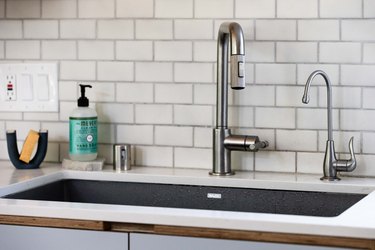Lots of gummy, greasy and stringy food items go down the kitchen sink drain, including rice, pasta, kitchen grease, and bits of celery and other fibrous vegetables. If you don't maintain the drain regularly by pouring in something to loosen things up — such as vinegar, salt, baking soda or a combination of these natural household drain cleaners — you'll probably have to clear a clog at some time or another. If clogs develop even when you do treat the sink, you could have a blocked vent.
Plunge the Sink
Video of the Day
In many cases, a plunger is the only tool you need if your kitchen sink won't drain, but you have to use it correctly to maximize its effectiveness. You need a sink plunger, which is the familiar hemispherical rubber one you find in most houses. A toilet plunger — which is larger and bell-shaped — won't work as well, and you probably don't want to use one in your sink anyway.
Video of the Day
How to Unclog a Kitchen Sink with a Plunger
Cover the sink overflow holes with duct tape to concentrate the force of the plunger on the blockage. If it's a double sink, put the stopper in the drain you aren't plunging. Fill the sink with about an inch of water.
Fit the plunger tightly around the drain with the handle pointing straight up, and pump several times. Remove the plunger and let water drain. Repeat as many times as necessary.
Use a Snake to Clear the Drain
Use a sink auger to clear a stubborn clog that you can't clear with a plunger. To start, insert the auger into the sink drain and push it until it won't go any farther.
Crank the handle of the auger while keeping gentle forward pressure. This works the head into the material forming the clog. Pull the auger out of the sink after cranking for about a minute. It should pull the material out with it.
Clean the P-Trap
Some glutinous food items, such as pasta and rice, settle at the bottom of the P-trap, out of reach of an auger, and they are too gooey to move with a plunger. You may have to remove the P-trap and manually clean it.
First, unscrew the connector holding the P-trap to the drain tailpiece, which is the pipe that extends down from the drain. If you can't turn the nut by hand, use adjustable pliers. Unscrew the connector on the back of the horizontal section of the trap in the same way.
Next, pull the trap down from the tailpiece and move it forward to separate it from the wall drain. Keep it upright until you can dump the water out in a bucket or outside. Clean out the trap with soap and water and a bottle brush. Finally, reassemble the trap, and tighten the connectors by hand or with pliers.
Vent Stack Blockages
The kitchen sink drain — like all the drains in the house — is connected to the main vent stack that extends through the roof. When this stack gets blocked, water drains slowly — and you'll probably notice slow draining in other sinks, drains and toilets. It's usually easy to clear the vents, but it involves going up on the roof.
Once you're safely on the roof, remove debris, such as leaves and sticks, from the opening of the vent pipe, which is usually above the main bathroom. Spray water into the vent using a garden hose in order to clear deeper blockages. Use a sewer auger to clear the blockage if water overflows from the vent.
When to Call a Professional
If you've tried a plunger, cleaned the P-trap, cleared the vent, and snaked drain, it's possible that the kitchen sink clogged past the trap. A professional plumber will have a longer drain snake to work through the pipes.
Although it's tempting to use a caustic drain cleaner as a quick solution, drain cleaners that contain sodium hydroxide — lye — are dangerous. They can damage your pipes and give you burns, and they are bad for the environment. If you have used one of these cleaners recently, exercise extreme caution when using any mechanical method to clear the drain.
